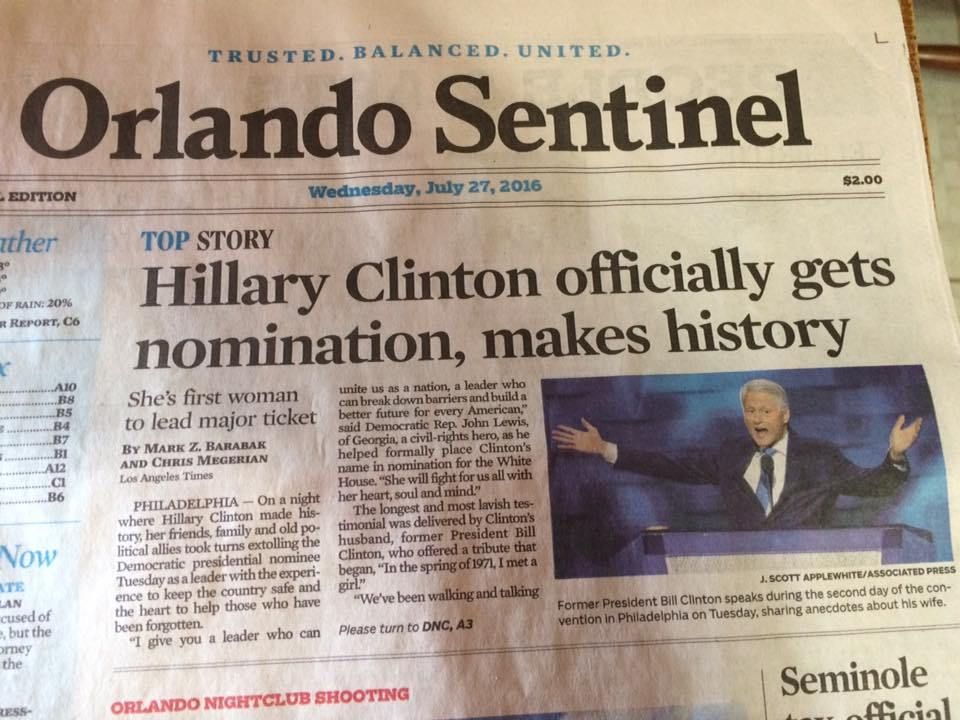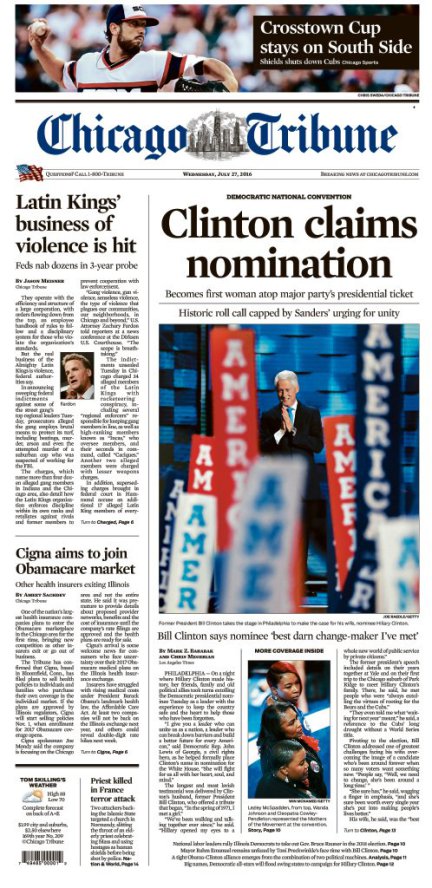
The front page of the Orlando Sentinel on Wednesday, July 27, 2016.
This post originally appeared at AllDigitocracy.org.
Hillary Rodham Clinton made history July 25, shattering the glass ceiling in American presidential elections by becoming the first woman nominated by a major political party for the highest office in the land. But you wouldn’t know that by looking at today’s front pages of several major American daily newspapers.
 The Chicago Tribune and The Orlando Sentinel get the headlines right, but then both displayed images of former president Bill Clinton under them. Why did these editors promote their front pages with Bill Clinton’s image and not that of the historic nominee?
The Chicago Tribune and The Orlando Sentinel get the headlines right, but then both displayed images of former president Bill Clinton under them. Why did these editors promote their front pages with Bill Clinton’s image and not that of the historic nominee?
When John Cutter, managing editor for The Orlando Sentinel, first saw it, he said he did react to the contrast of the photo against text about Hillary Clinton’s nomination. But, Cutter added, he wasn’t surprised that a photo of the former president was used.
“Bill Clinton was the featured speaker. Hillary Clinton didn’t appear except for a video,” Cutter added. “I’m not going to run a file photo of a live event.”
Cutter said he had not had a chance to speak with the editor who signed off on the layout Tuesday night, so he doesn’t know what factors played into the decision to put Bill Clinton on the front. When asked whether he thought the front page came across as sexist, Cutter shot back: “No,” he said. “Not at all. I just worried that we’d run into some deadline issue that prevented us from getting the best photo. I’m not sure that’s what happened. I don’t yet know what other choices they had.”
What’s worse is that The Tribune is located in Hillary’s home state. She grew up in Park Ridge, Illinois, less than an hour’s drive to Tribune headquarters. Surely Tribune editors could have done better, especially for a former local. Clearly both newspapers could have used images from their archives.
But they are not alone: The Washington Post, the Los Angeles Times and The Buffalo News (see their explanation below) did it too.
So what went wrong?
In fairness, perhaps one of the coolest images of the night — the breaking of glass to reveal Hillary Clinton via video — came after both newspapers went to press. Maybe. Or maybe they planned to use photos of Hillary Clinton when she formally accepts the nomination on Thursday. Such obviously flawed front pages may also be a result of what happens when word editors and photo or graphics editors don’t work hand-in-hand.
Still, something about this just ain’t right. Especially when other news organizations were able to work in Hillary Clinton’s photo, despite her absence from the convention.
I guess it could have been worse: The Oregonian didn’t even put Hillary Clinton’s nomination in their front-page headline. Instead, editors there did include her mugshot in a one-column wrap-up of Democratic convention news. They ran the history-making news on an inside page with a photo of women delegates holding placards of “HILLARY” in big, block letters. So there’s that.
Brian Connelly, managing editor of The Buffalo News, did offer an explanation. He said he received emails and had seen social-media discussions about his paper’s front page. His staff also discussed the page in Wednesday morning’s news meeting.
“I’m aware that people aren’t happy,” Connelly said. “I think I would have done it differently. But that’s easy to say after that fact as I look at the paper for the first time over my morning coffee. I think we have to keep in mind that the editors making these decisions are doing so on deadline. They are juggling multiple photos, multiple stories and multiple pages. These are humans making the best decisions they can on deadline, often involving factors not in their control.”
“That said,” Connelly added, “I think it’s important to acknowledge mistakes and strive to do better next time.”
AllDigitocracy has placed phone calls and sent emails to other editors responsible for these front pages. A newsroom representative at The Chicago Tribune passed the buck to an editor at The Los Angeles Times. That editor emailed back saying she, in fact, did not make the final decision but that she’d pass my query up the chain to top editors.
Meanwhile, other news organizations got it right, including The Post Register in Idaho Falls, Idaho. The Post Register published images taken by Associated Press photographers. The images include photos of Clinton’s video appearance and of delegates waving posters containing her face. The Associated Press makes its images available to thousands of newspapers across the country. Some choose to use them, others don’t.
What editors who used photos of Hillary Clinton’s husband instead of her may not understand is how their audiences are viewing these front pages: Women everywhere are looking at these pages and saying “this is what erasure looks like.”
Erasure is a practice in which a dominant culture, for example white men, attempts to negate, suppress, remove and, in effect, erase the culture (or cultural achievements) of a subordinate culture. The idea of “civilizing” nonwhite people can be seen as cultural erasure.
By displaying her husband on the front page, and not Hillary Clinton, the news organizations are effectively undermining a significant moment in history. It may not be the editors’ intent, but intent is not what audiences see when looking at these front pages.
This is why more diversity is needed inside newsrooms. It’s why feminism is still needed. It’s why media watchdogs, including AllDigitocracy, need to continue calling out media bias. And it’s why Hillary Clinton’s face, not her husband’s, should be on these front pages.




